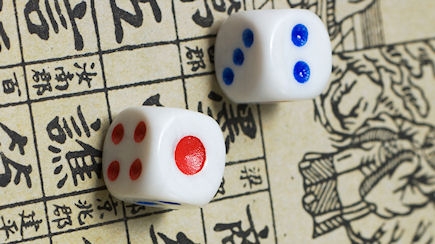This article first appeared in the Sep/Oct 2012 issue of World Gaming magazine.
Continuing our international mahjong series, this issue WGM explores “plus three” – the unique styling prevalent in Taiwan which uses an extra three tiles.
 The first time I visited Taipei was about six weeks before I was officially admitted into the Japan Professional Mahjong League. Naturally on my trip I wanted to pick up some authentic Chinese mahjong tiles, but coming from Japan where most sets are bought in toy stores or over the internet, I had no idea where to start searching. It turned out there wasn’t much searching needed.
The first time I visited Taipei was about six weeks before I was officially admitted into the Japan Professional Mahjong League. Naturally on my trip I wanted to pick up some authentic Chinese mahjong tiles, but coming from Japan where most sets are bought in toy stores or over the internet, I had no idea where to start searching. It turned out there wasn’t much searching needed.
Gambling is not allowed in Taiwan and this translates to a one mahjong table limit per household. That still gives scope for an enormous number of mahjong tables, and there are small mahjong specialty stores all over Taipei with a variety of tiles, sticks for straightening walls and other mahjong accessories. You can even get single replacement tiles if you’ve lost one. The quality of the sets is good and the prices are even better. On my trip I chose a heavy set with sparkly blue backs. Taiwanese mahjong uses a six-sided die to show which round it is, something we don’t have in Japan, so the clerk threw in one of those and matching blue sticks to go with my set, along with a stack of thin paper to protect table tops and tiles. This paper is another thing I saw for the first time since I generally play on mats, automatic tables or felt card tables.
Mahjong is extremely popular throughout Taiwan and most people learn to play by watching their grandparents or parents at family gatherings. It is so popular that many of the large international tournaments held in Macau in the past were run by companies based in Taiwan. But Taiwanese mahjong is also unique.
While most versions of the game hold 13 tiles in a working hand and 14 for a winning hand, Taiwanese rules add an extra group, so a hand in play holds 16 tiles and a winner uses 17. This makes for plenty of rule variations. Another special feature is that while the “deal” rotates around the table like other versions of the game, the East seat is decided by where the wall is split, which in turn determines the seat winds and seat flowers/seasons of each player. The game is played with 8 flower/season tiles in addition to the basic 136 in a deck.
 My colleague Garthe Nelson and I were lucky enough to be invited to play in a tournament in Taipei a few years ago and I have to say the players in Taiwan were the nicest and most fun group that I’ve had the pleasure to play with in my six year career. If you’ve never played before your opponents will be happy to teach you and even give you tips to win. It’s a great culture to learn the game in and a great environment to improve your skills as a player.
My colleague Garthe Nelson and I were lucky enough to be invited to play in a tournament in Taipei a few years ago and I have to say the players in Taiwan were the nicest and most fun group that I’ve had the pleasure to play with in my six year career. If you’ve never played before your opponents will be happy to teach you and even give you tips to win. It’s a great culture to learn the game in and a great environment to improve your skills as a player.
The popularity of the twist of an extra set in your hand is beginning to spread and there are many players in Hong Kong picking up this version lately as well. I have to admit, it’s a fun game to play. If you’re in Taiwan you’ll have to find a home that has an open seat at the sole table in their house, but if you’re in Macau and up for a game of Taiwanese mahjong, give me a holler. I love a good 16-tile hand. Maybe I’ll even bring my sparkly tiles.







